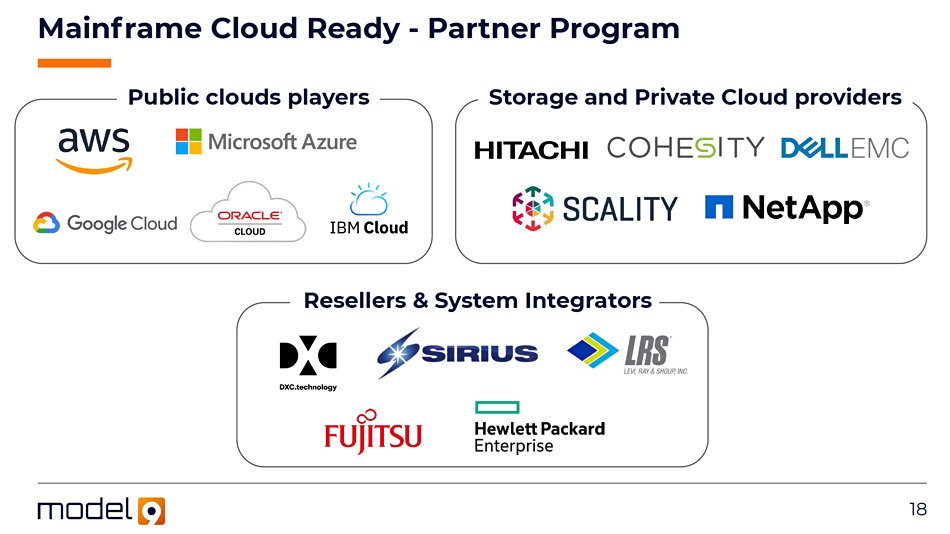Model9, a storage startup, is parlaying its software that replaces mainframe tape backup into a cloud data services gateway. The company has a big ambition – namely to replace virtual tape libraries (VTLs) in mainframe installations and enable cloud data services for mainframe users. Let’s take a closer look.
Nearly all mainframe customers use tape-based backup, either to actual tape libraries or to disk-based VTLs. Model9’s software runs on a IBM mainframe and backs up data to networked object storage – either an on-premises object store using the S3 protocol or to the AWS S3 or Azure Blob storage repositories.
Model9 provides backup, restore, archive/migrate, and automatic recall for mainframe data sets, volume types and z/OS UNIX files, plus space management, stand-alone restore, and disaster recovery. It supports AWS S3, Glacier, EBS (Elastic Block Store) and EFS (Elastic File System) with a Model9 Management and Proxy server running in AWS and a lightweight agent running in z/OS.
In 2019, the product was branded Cloud Data Gateway for z/OS – reflecting its function as a mainframe backup and database image copy data mover to the cloud. Last year the company changed the product’s name to Cloud Data Manager for Mainframe (CDMM), in order to plant the idea that the data could be used in business intelligence and analytics routines once it had been moved to the cloud. The neat thing was that such processing could return faster results than analysing the mainframe data on premises, according to CEO Gil Peleg.
In a press briefing this week, he claimed: “IBM doesn’t offer a mainframe compute service in the cloud,” so mainframe users have no easy way in the IBM environment for moving mainframe data and workloads to the public cloud. This is Model9’s big market opportunity.
The worldwide mainframe market comprises maybe 5,000 customers, mostly very large enterprises, that run mission-critical applications on their expensive big iron. Their data footprint is growing. Of course these customers also have X86 servers and can run business intelligence or data warehouse routines to analyse the data on those servers. Alternatively, they can send mainframe data to the cloud for analysis. But this is costly.

Mainframe backup to tape is a serial process whereas Model9 backup to the cloud or on-premises object stores is a parallel process.
Also, mainframe data has to pass through an Extract, Transform and Load (ETL) process to be converted into a form analytics routines on connected servers could use, Peleg said. The ETL processing consumes chargeable mainframe processor cycles (MSUs or Million Server Units) as do the FTP routines to ship the transformed data across network links to the analytic servers. Customer software monthly license charges are also increased.
Model9’s application uses a non-billable zIIP (z Systems Integrated Information Processor) and so doesn’t consume chargeable MSUs. That makes it cheaper to run. The software ships the data across TCP links to on-premises object stores or to the public cloud, and data delivery can be scheduled at a desired frequency – every 30 minutes, for example – to analyse up-to-date data.
The backup data can be put into S3 Object Lock stores for immutability, in order to provide equivalent ransomware protection to mainframe air-gapped tapes.
Model9 has built Data Transformation Service in AWS to convert the backed up mainframe data from its native format into CSV or JSON files which can then be used by Amazon Athena, Aurora, RedShift, Snowflake, Databricks and Splunk. Peleg said: “This is a strategic direction for us.”
The company has also extended the features of its mainframe software so that data transfer to the cloud is improved and mainframe users can operate the in-cloud processes directly. Here is a list of recent updates.
- March 2020 – CDMM v1.5 – supported transferring tape data directly to the cloud with no need for interim disk storage.
- September 2020 – CDMM v1.6 – perform on-demand data set level archiving operations directly from the mainframe to any cloud or on-premises system.
- November 2020 – CDMM v1.7 – perform all backup, archive, and restore operations directly from the mainframe to any cloud or on-premises system, eliminating the need to manage cloud data using external, non-mainframe systems.
- January 2021 – CDMM v1.8 – streamlined processes and at-a-glance system health and connectivity data for the Model9 management server and database, and object storage service.

Model9 this month joined the AWS Marketplace and achieved AWS Migration Competency. It is partnering with public cloud suppliers, on-premises object store providers and is also an IBM partner as Big Blue sees its software as a way to keep mainframes relevant in the cloud era.
Peleg said: “The cloud market and data are both growing. The opportunity is huge.” Model9 intends to develop its cloud data services further, adding data discovery, audit and reporting services.








